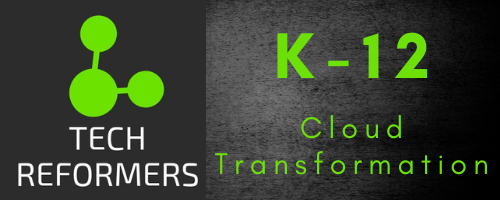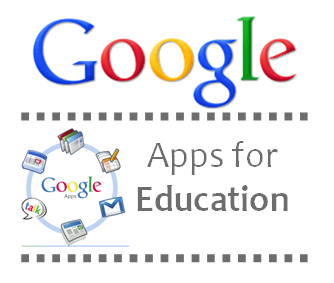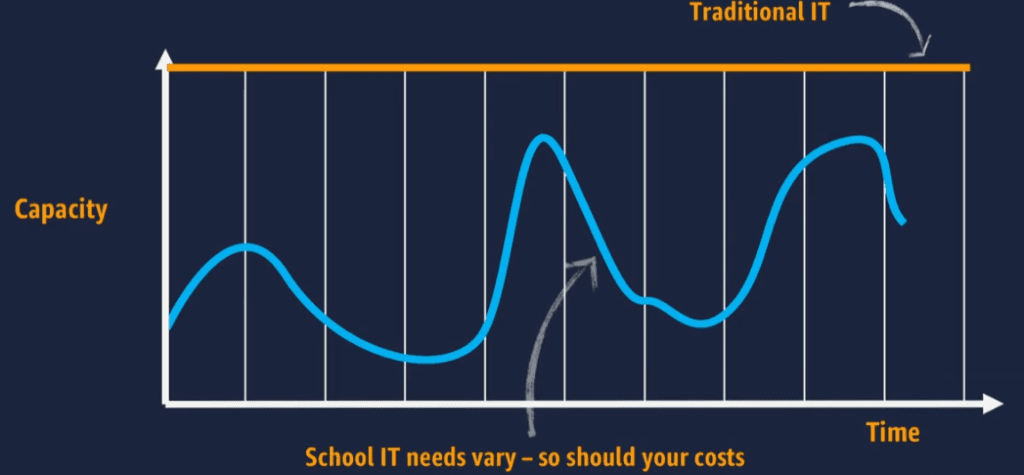
Organizations want to spend money wisely, whether private sector, non-profit, government, or a school district. Superintendents and CFO’s strive for effective use of capital and operational cost savings. Operations leaders want the agility to meet the immediate needs of the district. CTO’s want a secure and resilient infrastructure that allows for innovation. And all school district leaders pursue equity to meet the needs of each student. What makes this all possible today? The cloud or “cloud computing.” The public cloud powers digital transformation that is impossible or impractical in traditional data center infrastructure that, today, still many districts operate.
EdTech companies have leveraged the public cloud for years. But, districts themselves have lagged. We’ll look at what the cloud is and how districts can leverage the advantages of the public cloud.
Google Apps

The cloud in K-12 began with Software as a Service (or SaaS). Third parties started to offer software on their cloud. In 2006, Google began to provide Google Apps and, from the beginning, it was free to schools. I had recently started at Envision Schools, a public charter school in the Bay Area. Google Apps appeared to be great for our students and staff. Our Microsoft Exchange server was a lot of overhead for our small organization. Consequently, I rolled it out Google Apps that summer for the start of the next school year. Most school districts have adopted Google (See below). So, today, couldn’t it be similarly said that much of the legacy data center infrastructure is overhead?
Google’s then vice president and general manager for enterprise, ironically a former colleague, outlined the benefits for customers.
“Organizations can let Google be the experts in delivering high-quality email, messaging, and other web-based services while they focus on the needs of their users and their day-to-day business.”
(2006 Google Press Release)
As they say, the rest is history. Today, Google Workspace, née Google Apps, controls over 80% of the EdTech Apps in the Education market and has 8 of the top 10 apps as measured by Learn Platform.
Chromebooks
Google was able to start a revolution in K-12 by offering its services on the cloud. The cloud provided simplicity, scalability, cost savings, agility, redundancy, and security that both Google and school districts needed. When Google added the Chromebook several years later, again, it leveraged the cloud. Management and storage leveraged the cloud while eliminating software on the device, so the browser did all the work. In 2013-2014, when I was Oakland Unified School District, we rolled out Google Chromebooks. Students and staff embraced Personalized Learning and equitable access (and a platform for online testing, not so much). At the time, Miquel Helft outlined the “The Dawn of the Chrome Age” in Fortune Magazine on April 10, 2014.
Today, almost every EdTech app runs in the cloud, also called Infrastructure as a Service (IaaS). Most are on Amazon Web Services (AWS). As Bill Maher says, “I don’t know for sure, but I know it’s true.” EdTech companies choose the public cloud, AWS, Microsoft Azure, or Google Cloud Platform (GCP) because of the growing capabilities the cloud brings. Let’s look at some of the attractive features of the public cloud. And why IaaS is becoming the infrastructure of choice for most use cases universally.
Use of Capital

One of the first considerations is the use of capital. In the old days, organizations invested in expensive hardware just to get started. This would include servers, network hardware, cabling, data centers, cooling, electrical upgrades, real estate, and a long-term internet contract. Organizations also had to guess their need and often over-provisioned to not be caught under-resourced. All of this was a considerable capital expense that only well-funded or highly taxed organizations could afford. School districts were faced with large bond measures or capital levies just to leverage the internet. These cost then repeat themselves.
Today, with the cloud, organizations need less capital investment. Expenses move from capital to operating expenses. Organizations can start up in the cloud at no cost. AWS, Microsoft Azure, and Google Cloud Platform (GCP) offer a free tier! You can then scale as applications and users come on board. Entrepreneurs with a good idea can start by simply building out what is needed with some or all services free. Any school district can cut down on upfront purchases. There is no need with the public cloud for large capital purchases of hardware. So the first advantage of the cloud is moving significant capital expenses to more nominal operating costs. If a district wants to use its capital funds, spend less upfront!

Agility and Scalability
The second advantage, related to the first, is agility and scalability. As I said, the cloud enables districts to start small, yet it allows them to be agile. IT can scale up (bigger, more powerful servers) or scale-out (more servers) as needed and when needed. The actual need determines whether to go quickly or slowly. In the cloud, servers can even be set to auto-scale. Hence, resources automatically expand when needed and, notably, scale down to save costs when the resources are no longer required.
Cost Savings
This leads to the third advantage, related to the first two, bottom-line cost savings. Traditionally organizations have had to over-provision for their busiest time. Imagine the early days of Amazon where they needed enough capacity for the Holiday shopping season. But servers sat idle the rest of the year. (That extra capacity is what gave them the idea to rent out their excess capacity and why we have AWS.). Now there is no need with the cloud to buy extra capacity for busy times or “just in case.”
Similarly, the cloud enables users to turn off and not pay for resources that are not needed. For example, organizations turn off servers at night when they are only used during business hours. Or IT can only start development (Dev) or testing (Test) servers when required. In the old days, organizations would purchase complete environments for Dev and Test and run 24×7 with requisite space, electricity, and cooling. The public cloud does not charge for servers that are not running. The cloud enables considerable cost savings when school districts manage their workloads and only pay when used.
Facility Costs and “Going Green”
Another area for cost savings that school districts often overlook is the facility costs. Often these costs are incurred not by IT, but a separate Facilities or “Buildings and Grounds” department. These costs include real estate, building space, electricity, fire suppression, cooling, and generators. These are all costs built into cloud services and are areas for savings for school districts. Cloud providers are experts in these areas, have huge economies of scale, and build the best, most cost-efficient infrastructure. AWS, for instance, describes its green initiative.
“AWS has a long-term commitment to use 100% renewable energy. When companies move to the AWS Cloud from on-premises infrastructure, they typically reduce carbon emissions by 88% because our data centers can offer environmental economies of scale. Organizations generally use 77% fewer servers, 84% less power, and tap into a 28% cleaner mix of solar and wind power in the AWS Cloud versus their own data centers.“
GREENER IN THE AWS CLOUD
Why should districts try to build data centers and pursue green initiatives when the cloud can efficiently and environmentally be the data center? Then push the local utilities to offer green power for the rest. Some are close like Seattle with 97% renewable energy.
Resiliency and Security

While districts eliminate significant capital investments, save money, and improve agility, they also strengthen resiliency and security, our fourth advantage. The public IaaS providers, AWS, Azure, and GCP, protect the security of the cloud. They provide physical security and resiliency/redundancy of the data centers. Availability zones (AZ’s or groups of data centers) and regions (geographically isolated areas with AZ’s) compound resiliency and redundancy.
I have some district data center memories. I remember when I was at Fremont Unified, and a water pipe broke. So we had water flowing under our district office data center! At Oakland Unified, the data center overheated, setting off alarms late at night. When I went in, scaffolding fell and barricaded me in the 110-degree room. At Seattle Public Schools, the Facilities department turned off electricity to the data center over a weekend, and the generator failed to kick in. Infrastructure as a Service, the cloud, will let districts avoid these war stories.
The public cloud also excels at backup and disaster recovery. Besides the ability to replicate over AZ’s and regions, the cloud has built-in backup, replication, serverless architecture, and security services that further improve resiliency and security. Many of these are at no additional cost.
Simply by using public cloud resources, districts get world-class security and resiliency unfeasible for most to build and staff on their own. Reducing risk is a significant advantage for K-12 leaders.
Be Wary of Misconfiguration Anywhere there is Data
Yet, despite cloud advantages, organizations must still provide security in the cloud. District IT engineers and administrators must configure and administer applications correctly. IT must secure access and networks. Like traditional data centers, stakeholders must govern access.
Misconfiguration is, by far, the biggest reason for public cloud data breaches per the Cloud Security Alliance. But, districts can improve their security and resiliency with diligent engineering and administration. The public cloud also offers excellent tools for security, access, and logging. Districts now can free up IT staff from running physical servers and data centers allowing them to concentrate on security and resiliency “in the cloud” along with innovation to pursue district goals.

These first four advantages of cloud computing, the wise use of capital, agility, cost savings, and improved security and resiliency, are enough for many to move to the cloud. But the first four are merely operational and tangible improvements that don’t capture some of the long-term value of cloud transformation. We will wrap up with advantages that produce better outcomes for district leaders, teachers, and students.
Innovation
The fifth advantage is innovation. The cloud offers many avenues for districts to improve efficiency, one area for innovation. Many districts see the efficiency advantages in their SaaS applications. Email has become more reliable. Saving documents on the cloud enables files to be available across devices. New applications are easy to find, adopt, and use, thanks to SaaS cloud applications. But Infrastructure as a Service, IaaS, has its own advantages. Districts can adopt cloud-enabled business process automation and “going paperless” in ways more potent than district data centers offer. The cloud can tap into Artificial Intelligence (AI), unavailable in data centers. Machine Learning (ML) takes process automation and digitization to new levels. Now districts can do not only complex text and image recognition but also video and language processing.
Similarly, AI and ML can help with student data. Seattle Public Schools envisioned a system on the AWS Cloud as part of the City on a Cloud Innovation Challenge. Advanced data services, such as predictive analytics was not possible with their on-premises infrastructure.
Equity
What the big companies might not think about when it comes to the cloud is equity. But the cloud can enable just that. As explained above, advanced data analytics, Artificial Intelligence, and Machine Learning can bring new insights to data. Heretofore, educators think of metrics then plot data against a known metric. But what if AI could surface causality from disparate data points unimagined by educators or traditional data systems? New insights enabled by the cloud could bring avenues to closing opportunity gaps. Cloud data capabilities can help ensure educators meet the needs of each individual student.
Remember the Chromebook, part of the cloud revolution in education? Chromebooks had 60% of the Education marketing in 2018. But, the demand exploded with the pandemic, and 30 million Chromebooks shipped in 2020. While we wait for the actual estimate of the percentage of Chromebooks in schools in 2021-2022, we need to address an equity gap. “What?” you say, “Haven’t Chromebooks improved equity by providing equitable access to devices?” True. Low-cost, web-only computers expand the breadth of distribution, closing the so-called homework gap. However, there’s now a gap between those with powerful full-featured multimedia workstations at home and those with just a district-issued Chromebook.
Cloud Brings Equity
While some students go home with just a Chromebook, others eschew the simple laptop and log into their desktop. A powerful processor and graphics card enables them to go deeper into programs introduced at school in CTE, graphics, multimedia, computer science, and other classes. Programs such as Adobe Photoshop, Adobe Premiere, Autodesk, Blender, and Visual Studio need a standard Windows or Mac computer. Or these privileged students may do competitive gaming, now an avenue to a college scholarship. Students with just Chromebooks are missing out again on opportunities.
But wait. With the cloud, Infrastructure as a Service – IaaS, that opportunity gap disappears. A Chromebook or any home computer with an internet connection can tap into all the powerful applications streaming from powerful computers in the cloud. Fife School District deployed AWS Workspaces and AppStream 2.0 to “make students innovators 24-hours a day,” and it “fills a void in equity in education.” Tech Reformers offers a streaming service for apps on a per-student subscription basis.
Districts Should Pursue Cloud Further
Like Google Apps and the Chromebook, the cloud is offering new opportunities for districts. CFO’s should be looking for wise use of capital and money savings. CTO’s should be gaining agility and scalability to efficiently meet district goals while improving security and resistance to lower district risk. All district leaders should recognize opportunities for innovation and equity with new data capabilities and resources only available in the cloud. It’s time to get on board with the cloud revolution.
